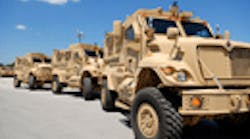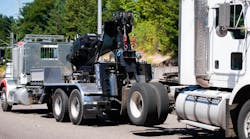BALTIMORE, MD. The U.S. military is increasingly scrutinizing hybrid powertrains for everything from ships to trucks as a critical piece of its “energy security” strategy for the future. The military believes that not only will hybrid powertrains help tactical and non-tactical equipment reduce fuel consumption, but they are also a way to boost the combat capability of its forces as well.
“The bottom line is we have an energy challenge, the same as the rest of America does; but one that is different as well,” explained Sharon Burke, assistant secretary of defense for operational energy plans and programs, at the 11th annual Hybrid Truck Users Forum (HTUF) National Conference & Expo being held here this week at the Baltimore Convention Center.
“But when we start looking at these energy challenges, we need to address military strategy as well,” she stressed. “The military’s global mission takes a lot of energy to accomplish and 99% of it comes from petroleum. So we need to take advantage of efficiencies where we can. But at the same time we also need to look at how alternatives offer greater capability to our armed forces, too, such as extending range, reducing noise levels, etc.”
As part of her duties, Burke heads up a broad energy strategy initiative crafted for the Dept. of Defense (DOD) back in June, which aims to reduce demand, find alternative energy sources, plus improve the energy security and capability of military operations.
From this perspective, hybrid powertrains – especially for trucks – are expected to play a significant role.
“Reducing fuel consumption means vehicles can stay in the field longer with less logistical support,” Burke pointed out. “In today’s operations, we haul fuel and other supplies across very challenging circumstances in Afghanistan, across difficult terrain and dangerous roads. The more that we can lighten that dependence, the more resilient we are to that changing strategic landscape.”
She added that vehicles in military operations often spend a lot of time sitting still in communication and intelligence-gathering missions. With hybrid systems, they could perform those duties more quietly with less, if any, fuel consumed.
“At the moment, we don’t factor in energy performance into combat equipment,” Burke said. “But we will get this opportunity as we begin to modernize and/or refurbish the combat equipment returning from Iraq and Afghanistan. This offers us a chance to make a change concerning fuel performance.”
Insulating the military from fuel-price volatility, while also reducing its monetary footprint as part of the federal government’s deficit reduction efforts, is another part of DOD’s energy strategy, she pointed out.
DOD as a whole makes up 80% of the federal government’s energy use, Burke noted, and 1% of the nation as a whole. It spent $15 billion on energy in 2010, 75% of which was for military operations. By the end of 2011, the military will have consumed 5 billion gallons of petroleum, costing some $20 billion, reflected the impact of higher prices this summer. DOD’s gasoline costs alone are up 225% this year from a decade ago.
“Our challenge is to adjust to such fiscal circumstances and sustain our military effectiveness today and far into the future,” Burke noted.
Also, every $1 increase in the price of oil adds $130 million extra to the Pentagon’s fuel budget, she said, making the U.S. military’s wallet particularly vulnerable to global swings in oil costs. “This summer, due to the increase in oil prices, we had to scramble to find nearly $2 billion extra to pay for our higher than expected fuel bill,” she explained – $2 billion that could have spent on other critical issues, such as training, Burke stressed.
“[That’s why] improving our energy [footprint] could not only improve our military effectiveness and our ability to operate in the world, but it is also important to our readiness,” Burke said. “Energy is a part of that changing security environment, but it’s also part of that adaptation, and how we better prepare for this changing world and the possibility of strategic surprise.”



